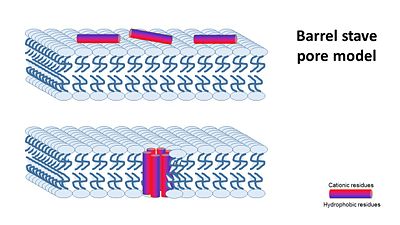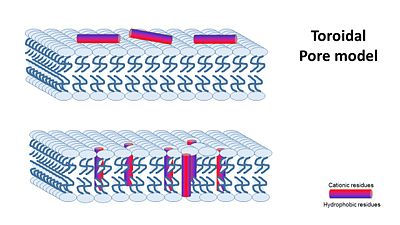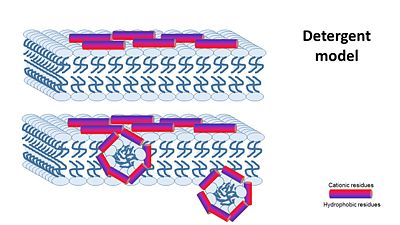Antimicrobial peptides
From Proteopedia
| (34 intermediate revisions not shown.) | |||
| Line 1: | Line 1: | ||
| - | == | + | ==Antimicrobial peptides== |
| - | <StructureSection load='3rec' size='350' side='right' caption='' scene='67/676980/4mgp_ala-mag/1'> | + | <StructureSection load='3rec' size='350' side='right' caption='Magainin 2 peptide (PDB code [[4mgp]])' scene='67/676980/4mgp_ala-mag/1'> |
==Introduction== | ==Introduction== | ||
| - | + | Antimicrobial Peptides (AMPs) are short peptides that consist of 10-50 amino acids, and were found to have antimicrobial influence on different kinds of bacteria and fungi. They are also called host defense peptides (HDPs) or defensins,Since they have different functions in their host. | |
AMPs are produced by Eukaryotes, as part of their defence mechanism from bacteria. They defend their host from bacteria, and also have physiological functions such as inflammation and wound healing (Wimley 2010) | AMPs are produced by Eukaryotes, as part of their defence mechanism from bacteria. They defend their host from bacteria, and also have physiological functions such as inflammation and wound healing (Wimley 2010) | ||
| - | Even though they have similar functions, AMPs lack any specific consensus amino acid sequences | + | Even though they have similar functions,'''AMPs lack any specific consensus amino acid sequences that are associated with biological activity'''. |
==History== | ==History== | ||
| - | Alexander Fleming | + | The first AMP was discovered by Alexander Fleming about 90 years ago. He recognized the presence of a soluble antimicrobial substance produced by human nasal secretions from a patient suffering from acute coryza. He called it [[Lysozyme]] as it performed lysis to bacterial cells. |
Subsequently, he found lysozyme antibacterial activity in various human physiological fluids and tissues of animals, as well as egg whites. | Subsequently, he found lysozyme antibacterial activity in various human physiological fluids and tissues of animals, as well as egg whites. | ||
| - | + | Since then, various natural examples for AMPs were found in all classes of organisms: animals including humans, invertebrate animals, plants, and fungi. | |
So far more than 1,200 types of peptides with antimicrobial activity have been isolated from various cells and tissues. | So far more than 1,200 types of peptides with antimicrobial activity have been isolated from various cells and tissues. | ||
| Line 22: | Line 22: | ||
Antimicrobial peptides are divided into subgroups on the basis of their amino acid composition and structure (ref nature review). | Antimicrobial peptides are divided into subgroups on the basis of their amino acid composition and structure (ref nature review). | ||
| + | |||
| + | ===<span style="color: blue">(1) Anionic peptides</span> === | ||
'''(1) Anionic peptides''' - Small anionic peptides rich in glutamic and aspartic acids from sheep, cattle and humans - they present in surfactant extracts, bronchoalveolar lavage fluid and airway epithelial cells. They are produced in mM concentrations, require zinc as a cofactor for antimicrobial activity and are active against both Gram positive and Gram-negative bacteria. | '''(1) Anionic peptides''' - Small anionic peptides rich in glutamic and aspartic acids from sheep, cattle and humans - they present in surfactant extracts, bronchoalveolar lavage fluid and airway epithelial cells. They are produced in mM concentrations, require zinc as a cofactor for antimicrobial activity and are active against both Gram positive and Gram-negative bacteria. | ||
• Maximin H5 from amphibians. | • Maximin H5 from amphibians. | ||
| - | • Dermcidin from | + | • As example we can see Dermcidin peptide from human source: you can see here the <scene name='67/676980/Hexameric_anti-microbial_pepti/1'>hexameric anti-microbial peptide channel dermcidin</scene>. The aspartic acid is colored red and the glutamic acid is colored blue <scene name='67/676980/Hexameric_anti-microbial_pepti/2'> in this scence</scene>. |
| + | ===<span style="color: blue">(2) Linear cationic α-helical peptides</span> === | ||
'''(2) Linear cationic α-helical peptides''' - contains ~290 cationic peptides, which are short (contain <40 amino acid residues), lack | '''(2) Linear cationic α-helical peptides''' - contains ~290 cationic peptides, which are short (contain <40 amino acid residues), lack | ||
cysteine residues and sometimes have a hinge or ‘kink’ in the middle | cysteine residues and sometimes have a hinge or ‘kink’ in the middle | ||
| Line 49: | Line 52: | ||
• LL37 from human - In water, it exhibits a circular dichroism (CD) spectrum that is consistent with a disordered structure.However, in 15 mM HCO3–, SO42– or CF3CO2–, the peptide adopts a helical structure. | • LL37 from human - In water, it exhibits a circular dichroism (CD) spectrum that is consistent with a disordered structure.However, in 15 mM HCO3–, SO42– or CF3CO2–, the peptide adopts a helical structure. | ||
| - | + | ===<span style="color: blue">(3) Cationic peptides enriched for specific amino acids</span>=== | |
'''(3) Cationic peptides enriched for specific amino acids''' - contains ~44 cationic peptides that are rich in certain amino acids. These peptides lack cysteine residues and are linear, although some can form extended coilsץ | '''(3) Cationic peptides enriched for specific amino acids''' - contains ~44 cationic peptides that are rich in certain amino acids. These peptides lack cysteine residues and are linear, although some can form extended coilsץ | ||
| Line 66: | Line 69: | ||
• Small histidine-rich salivary polypeptides, including the histatins from man and some higher primates116. | • Small histidine-rich salivary polypeptides, including the histatins from man and some higher primates116. | ||
| - | + | ===<span style="color: blue">(4) Anionic and cationic peptides that contain cysteine and form disulphide bonds</span>=== | |
''' (4) Anionic and cationic peptides that contain cysteine and form disulphide bonds''' - this group has ~380 members, contain cysteine residues and form disulphide bonds and stable β-sheets. | ''' (4) Anionic and cationic peptides that contain cysteine and form disulphide bonds''' - this group has ~380 members, contain cysteine residues and form disulphide bonds and stable β-sheets. | ||
| Line 89: | Line 92: | ||
• Peptides with >3 disulphide bonds include plant antifungal defensins and <scene name='67/676980/Drosomycin_nmr/1'>drosomycin</scene> in fruit flies. Drosomycin is the first antifungal protein characterized recently among the broad family of inducible peptides and proteins produced by insects to respond to bacterial or septic injuries. It contains <scene name='67/676980/Drosomycin_nmr/2'>3 disulphide bonds</scene>. | • Peptides with >3 disulphide bonds include plant antifungal defensins and <scene name='67/676980/Drosomycin_nmr/1'>drosomycin</scene> in fruit flies. Drosomycin is the first antifungal protein characterized recently among the broad family of inducible peptides and proteins produced by insects to respond to bacterial or septic injuries. It contains <scene name='67/676980/Drosomycin_nmr/2'>3 disulphide bonds</scene>. | ||
| - | + | ===<span style="color: blue">(5) Anionic and cationic peptide fragments of larger proteins</span>=== | |
''' (5) Anionic and cationic peptide fragments of larger proteins''' - these fragments have antimicrobial activity and are similar in composition and structure to the antimicrobial peptides described above. However, their role in innate immunity is not yet clear. | ''' (5) Anionic and cationic peptide fragments of larger proteins''' - these fragments have antimicrobial activity and are similar in composition and structure to the antimicrobial peptides described above. However, their role in innate immunity is not yet clear. | ||
| Line 108: | Line 111: | ||
===Secondary structure=== | ===Secondary structure=== | ||
| - | AMPs structure allows them to interact with negatively charged phospholipid head groups of microbial membranes, resulting in pore formation (or other mechanism | + | AMPs structure allows them to interact with negatively charged phospholipid head groups of microbial membranes, resulting in pore formation (or other mechanism) on the bacterial membrane . |
Although AMPs have the same effect on the cell mambrane, they do not seem to have the same structure. we can find a big variety of structures among familiar AMPs. | Although AMPs have the same effect on the cell mambrane, they do not seem to have the same structure. we can find a big variety of structures among familiar AMPs. | ||
| - | (1) Some have '''helical structures''', for some of the peptide sequence, such as | + | (1) Some have '''helical structures''', for some of the peptide sequence, such as ,<scene name='67/676980/Magainin/1'>Magainin</scene>, or a helical structure throughout the whole peptide, such as <scene name='67/676980/Magainin_2_simple/1'>Magainin 2</scene>. this peptide was found on a frog's skin. you can see the page about Magainin2 here : [[Magainin 2]]. |
(2) '''Beta-sheet structures''': | (2) '''Beta-sheet structures''': | ||
| Line 125: | Line 128: | ||
==Suggested Mechanisms== | ==Suggested Mechanisms== | ||
| - | The | + | For killing the bacteria, AMPs must first attracted to bacterial surfaces. The attraction is electrostatic bonding between anionic or cationic peptides and structures on the bacteria's membrane. Studies on membrane models contained vary compositions of charged phospholipids proved this mechanism of attraction. But, bacteria membranes are more complex than mebrane models. Gram negative - Cationic AMPS suggested to be attracted to the net negative charge on the puter mmebrane (phospholipids to phosphate groupf of lipopolysacharides). Gram positive - AMPSs suggested to be attracted to the trichoic acids ob the surface. |
| + | Now, the peptides are attached to the cell. However they have to tranverse the lipopolysacharides or extracellular polysacharides so they can contact and act on the outer membrane. the specific mechanism of this step is unclear so far. | ||
| - | There are a few suggested machanisms of how AMPs work(William C. Wimley, ACS CHEMICAL BIOLOGY, 2010). | + | |
| + | The way how different antimicrobial peptides insert and act on the membrane goal appears to be different and depends on the peptide, the membrane and the peptide/lipid ratio. | ||
| + | |||
| + | At low peptide/lipid ratios, peptides are oriented parralel to the lipid bilayer, | ||
| + | As the peptide/lipid ration increases, peptides are oriented prependicular to the membrane and insert inside it, forming transmembranes pores. | ||
| + | |||
| + | There are a few suggested machanisms of how AMPs work (William C. Wimley, ACS CHEMICAL BIOLOGY, 2010). | ||
They can be divided into two: | They can be divided into two: | ||
(A) Transmembrane Pore Models of AMP Membrane Activity and (B) Nonpore Models of AMP Activity | (A) Transmembrane Pore Models of AMP Membrane Activity and (B) Nonpore Models of AMP Activity | ||
In the Transmembrane Pore Models, it is suggested that AMPs form many pores in the mambrane, so that it cannot hold it's content anymore. | In the Transmembrane Pore Models, it is suggested that AMPs form many pores in the mambrane, so that it cannot hold it's content anymore. | ||
| - | + | The''' transmembrane pore mechanism''' has 2 main models: | |
| - | + | ||
| - | + | ||
| - | + | ||
| - | + | ||
| - | + | '''1- barrel stave pore model''' ,that claims peptides interact laterally with one another to form a specific structure enclosing a water-filled channel, much like a protein ion channel. | |
| + | [[Image:Barrel stave pore model.JPG|center|400px]] | ||
| - | + | '''2- toroidal pore model''', that claims specific peptide–peptide interactions are not present, and instead, single peptides are bound to the membrane’s phospholipids and disturbe it’s structure.. | |
| + | [[Image:Torodial pore model.JPG|center|400px]] | ||
| + | the '''Nonepore model''' claims peptides bind to the membrane until it collapses. It is devided into 2 main mechanisms: | ||
| + | '''1- The carpet model''': In this model, antimicrobial peptides accumulate on the membrane surface with an orientation that is parallel to the membrane.When peptide concentration has reached a critical level permeabilization occurs via global bilayer destabilization. | ||
| + | '''2- detergent model''' : collapse of membrane integrity, observed with some AMPs at high peptide concentration. | ||
| + | [[Image:Detergent model.JPG|center|400px]] | ||
| + | == Relevance == | ||
| - | + | [[magainin 2]] | |
</StructureSection> | </StructureSection> | ||
== References == | == References == | ||
| + | 1- '''J. Gesella., M. Zasloffb and S. J. Opellaa'''., Two-dimensional H NMR experiments show that the 23-residue magainin antibiotic peptide is an α-helix in dodecylphosphocholine micelles, sodium dodecylsulfate micelles, and trifluoroethanol/water solution. ''Journal of Biomolecular NMR'', 1997. 9: 127–135 | ||
| + | |||
| + | 2- '''Z. Hayouka., D. E. Mortenson., D. F. Kreitler., B. Weisblum., K. T. Forest, and S. H. Gellman'''., Evidence for Phenylalanine Zipper-Mediated Dimerization in the X‑ray Crystal Structure of a Magainin 2 Analogue. ''J. Am. Chem. Soc'', 2013. 135: 15738−15741. | ||
| + | |||
| + | 3- '''T. Nakatsuji., & R. L. Gallo'''., Antimicrobial Peptides: Old Molecules with New Ideas. ''Journal of Investigative Dermatology'', 2012. 132: 887-895. | ||
| + | |||
| + | 4- '''K. A. Brogden'''., ANTIMICROBIAL PEPTIDES: PORE FORMERS OR METABOLIC INHIBITORS IN BACTERIA?. ''NATURE REVIEWS MICROBIOLOGY'', 2005. 3: 238-250. | ||
| + | |||
| + | 5- '''W. C. Wimley'''., Describing the Mechanism of Antimicrobial | ||
| + | Peptide Action with the Interfacial Activity Model. ''ACS CHEMICAL BIOLOGY'', 2010. 10: 905-917. | ||
| + | |||
| + | 6- '''W. C. Wimley., K. Hristova'''., Antimicrobial Peptides: Successes, Challenges and Unanswered | ||
| + | Questions. ''Membrane Biol'' ,2011. 239: 27–34. | ||
| + | |||
| + | |||
| + | |||
<references/> | <references/> | ||
Current revision
Antimicrobial peptides
| |||||||||||
References
1- J. Gesella., M. Zasloffb and S. J. Opellaa., Two-dimensional H NMR experiments show that the 23-residue magainin antibiotic peptide is an α-helix in dodecylphosphocholine micelles, sodium dodecylsulfate micelles, and trifluoroethanol/water solution. Journal of Biomolecular NMR, 1997. 9: 127–135
2- Z. Hayouka., D. E. Mortenson., D. F. Kreitler., B. Weisblum., K. T. Forest, and S. H. Gellman., Evidence for Phenylalanine Zipper-Mediated Dimerization in the X‑ray Crystal Structure of a Magainin 2 Analogue. J. Am. Chem. Soc, 2013. 135: 15738−15741.
3- T. Nakatsuji., & R. L. Gallo., Antimicrobial Peptides: Old Molecules with New Ideas. Journal of Investigative Dermatology, 2012. 132: 887-895.
4- K. A. Brogden., ANTIMICROBIAL PEPTIDES: PORE FORMERS OR METABOLIC INHIBITORS IN BACTERIA?. NATURE REVIEWS MICROBIOLOGY, 2005. 3: 238-250.
5- W. C. Wimley., Describing the Mechanism of Antimicrobial Peptide Action with the Interfacial Activity Model. ACS CHEMICAL BIOLOGY, 2010. 10: 905-917.
6- W. C. Wimley., K. Hristova., Antimicrobial Peptides: Successes, Challenges and Unanswered Questions. Membrane Biol ,2011. 239: 27–34.



